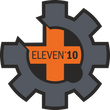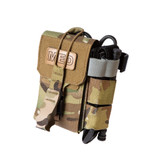Compressed Gauze vs. Hemostatic Gauze
The Efficacy of Compressed Gauze vs. Hemostatic Gauze in Controlling Uncontrolled
Hemorrhage
Uncontrolled hemorrhage is a critical medical emergency that can lead to severe complications and even death if not managed promptly and effectively. In such situations, the choice of wound dressing can significantly impact the outcome.
Compressed Gauze
Compressed gauze has been a staple in first aid and emergency medical care for many years. It is widely available, easy to use, and effective in absorbing blood and providing pressure to the wound. Compressed gauze physically blocks the wound and promotes clot formation through direct pressure. However, its efficacy is limited in cases of severe arterial bleeding, where the blood flow is too rapid for the gauze to control effectively. We have found the use of compressed gauze in the form of Kerlix in EMS, hospital, and earlier military field settings.
Often bulky and subject to wear in the field, modernized forms suited for austere and tactical environments have emerged. Manufacturers such as North American Rescue, H and H, and others have produced durably packaged, flat-packed versions with a longer expiry and easily opened units that optimize field applications.
Hemostatic Gauze
Hemostatic gauze, on the other hand, is specifically designed to enhance the body's natural clotting mechanisms or work independently of the body’s clotting cascade. These dressings are impregnated with hemostatic agents, such as kaolin, chitosan, or zeolite, accelerating the clotting process and helping achieve hemostasis more quickly. Studies have shown that hemostatic gauze can significantly reduce blood loss and improve survival rates in severe hemorrhage.
Significant advancements have been made in delivering hemostatic agents to the field environment. The use of zeolite-based powders has been reduced, as the thermogenic effect and amount of loose granules getting to the wound site were prohibitive. Kaolin, a clay-based mineral applied to the gauze, allows the more active component to "hit its mark" and has no heat-generating effects. Z-Medica's Combat gauze is the most notable and is used in the Civilian, LE, EMS, and Military sectors.
Chitosan, a shellfish-based component, is another hemostatic agent that has proven effective. Hemcon® dressings from Tricol Biomedical and Celox™ Medical incorporate chitosan. A common question surrounds the use of shellfish-based dressings in the medical setting. These will not affect those with shellfish allergies, as the active component is isolated in manufacturing.
Another advantage of hemostatic dressings is that some have incorporated X-ray detectable strips within the gauze so they can be seen during imaging, saving critical time and preventing complications in the total care of the patient.
Comparative Efficacy
In comparative studies, hemostatic gauze demonstrated superior efficacy over compressed gauze in controlling severe hemorrhage. Studies found that hemostatic gauze achieved hemostasis faster and with less blood loss compared to compressed gauze. Additionally, hemostatic gauze was more effective in cases of arterial bleeding, where compressed gauze alone was insufficient.
Combined use
From experience on the ground, an integration of both compressed and hemostatic gauze is both efficient, budget-friendly, and effective. Hemostatic gauze is effective only if it is in direct contact with the bleeding source, not just placed into the wound cavity. Therefore, when applied correctly, you can reduce the amount of costly and critical hemostatic gauze, transfer it to compressed gauze to essentially "fill the void," and use the pressure needed to achieve hemostasis. This is paramount when resources are finite, with the potential of multiple casualties.
Conclusion
In conclusion, while compressed gauze remains a valuable tool in wound management, hemostatic gauze offers a more effective solution for controlling uncontrolled hemorrhage. Its ability to accelerate clot formation and reduce blood loss makes it a superior choice in emergencies. Therefore, incorporating hemostatic gauze into first aid kits and emergency medical supplies can significantly improve outcomes for patients experiencing severe bleeding. By integrating compressed and hemostatic gauze into trauma care protocols, responders can be better equipped to manage a wide range of hemorrhage scenarios, ultimately improving patient outcomes and saving lives.
From individual body-worn kits (IFAKs) to TEMS medic support bags, Eleven 10® offers kits from authentic, reputable manufacturers that contain combinations of compressed and hemostatic gauze selected to suit your operating environment. Gear up!
Explore Popular Articles
Why Every Law Enforcement Officer Should Carry a Medical Kit
In high-risk professions like law enforcement, seconds can mean the difference between life and deat...
The New Eleven 10® Responder MINI IFAK
Meet the New Eleven 10® Responder MINI IFAK: The Best IFAK for 2025 At Eleven 10® (E10), we design g...
Compressed Gauze vs. Hemostatic Gauze
The Efficacy of Compressed Gauze vs. Hemostatic Gauze in Controlling Uncontrolled Hemorrhage Unco...
Why Investing in a Quality Tourniquet Could Save Your Life
When it comes to emergency medical gear, there’s one tool that stands above the rest for saving live...

